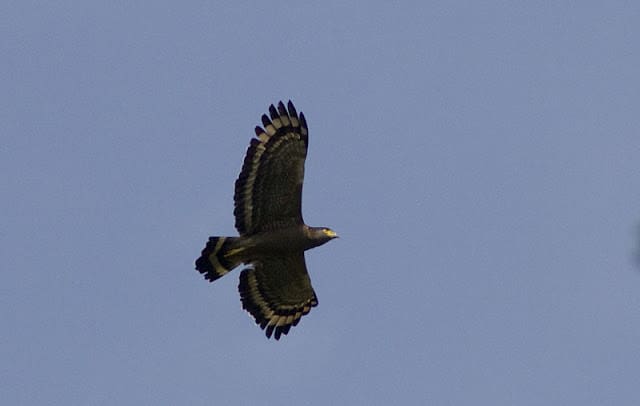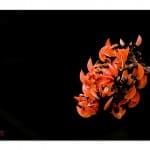Thattekad Bird Sanctuary, also known as Salim Ali Bird Sanctuary, is located between the branches of the Periyar River in Ernakulam district of Kerala. The great birdman Salim Ali had surveyed Thattekad in 1930 and described it as the richest bird habitat in the peninsula. He later urged the Kerala government to notify it as a sanctuary. In 1983, it was thus declared.
The sanctuary covers around 25 sq km of tropical semi-evergreen and tropical deciduous lowland forests. Hence the name (Thattekad literally translates to ‘flat forest’ in Malayalam). Our guide Sudeesh (a crack-shot at spotting) explained that excluding the settlements inside the forest the sanctuary is all of 15 or 16 sq km of actual forest cover. But that’s the most intriguing part: Within this small area reside over 250 species of birds, a density almost unheard of in the south.
Our stay at Thattekad was short (one and a half days and 77 birds spotted). Our first birding day began only at 8:30 AM. Sudeesh took us around past several estates that border the sanctuary. Despite that we spotted Ashy Woodswallows (Artamus fuscus) and the Mottled Wood Owl (Strix ocellata). Sudeesh took us to the tree where it usually roosts. The bird was so well camouflaged that it took me a while to locate it. Another raptor that we saw was the Crested Serpent Eagle (Spilornis cheela).
 |
| Ashy Woodswallows |
 |
| Crested Serpent Eagle |
At one of the estates, I saw a lizard steadily working its way up the trunk of a tree, all the while catching insects that it found on the bark. I paused for a second wondering if it could be the dragon that I’ve always longed to see. And the next second, when it exposed its yellow gular pouch, I knew it was the dragon – Draco dussumieri or the Western Ghats Flying Lizard! And although I couldn’t get a shot of it in flight, I did see it glide gracefully for a span of approximately 12 feet from one tree to another. It landed on the trunk, very close to the base of the tree and started moving up in the same fashion as it had done with the previous tree.
 |
| Western Ghats Flying Lizard. The skin membrane used for gliding is clearly visible |
Later in the evening we took the Salim Ali Nature Trail. This area was well-wooded and we encountered species like the Emerald Dove (Chalcophaps indica), Eurasian Blackbird (Turdus merula) and the Malabar Trogon (Harpactes fasciatus). Fellow-birder George saw a Mouse Deer (Moschiola meminna) run across the path just a few feet in front of him!

The next morning’s birding was productive with quite a lot of sightings. Around 7 AM, Sudeesh took us to a rocky outcrop near Kallipara that overlooks the core area of the sanctuary. This was an extremely good vantage point. All you had to do was select a suitable spot, sit and start watching. The birds were pretty good at running their show. Here we saw the Grey-headed bulbul (Pycnonotus priocephalus), Brown-capped Pygmy woodpecker (Dendrocopus nanus) and the Green Imperial Pigeon (Ducula aenea) among many others. We also spotted a Malabar Giant Squirrel (Ratufa indica) resting in the canopy.

 |
| The rock served as a good lookout point |
 |
| Hill mynas high in the canopy |
After spending a couple of hours there we proceeded on our final mission – to see the Sri Lankan Frogmouths (Batrachostomus moniliger). For this, Sudeesh took us to Urulanthanni. After alighting from the bus, he led us along the road and, leaning on a very thin tree, turned around and said, “On this tree, there are three frogmouths.” It took me a second to decipher what he had said. My jaw dropped as I looked above us. There, just three or four feet above where he stood, were three Frogmouths huddled together!
 |
| The camouflaged Frogmouth family |
The experience, though short, was great. An important thing I noticed about Thattekad was the absence of plastic waste. Nowhere on the trails did I find discarded plastic or other garbage. The forest floor was filled only with dry leaves. The people that I interacted with — the guide, cook, home-stay owner — all seemed to be aware of this and accept the fact that the birds are the actual source of their livelihood. They knew the importance of protecting the birds and the environment that they live in. This is the kind of spirit that local communities around a protected area should be encouraged to develop.
Photographs of the river and Kallipara rocks by George Tom
Text and photographs by Arun Menon
Latest posts by Arun (see all)
- Savannah Sprinter – A day at the office with the cheetah - April 9, 2020
- Mangalajodi – birds and serenity in a winter wetland - April 14, 2018
- Let the sleeping tiger lie – on meeting the big cat on foot - March 13, 2017





